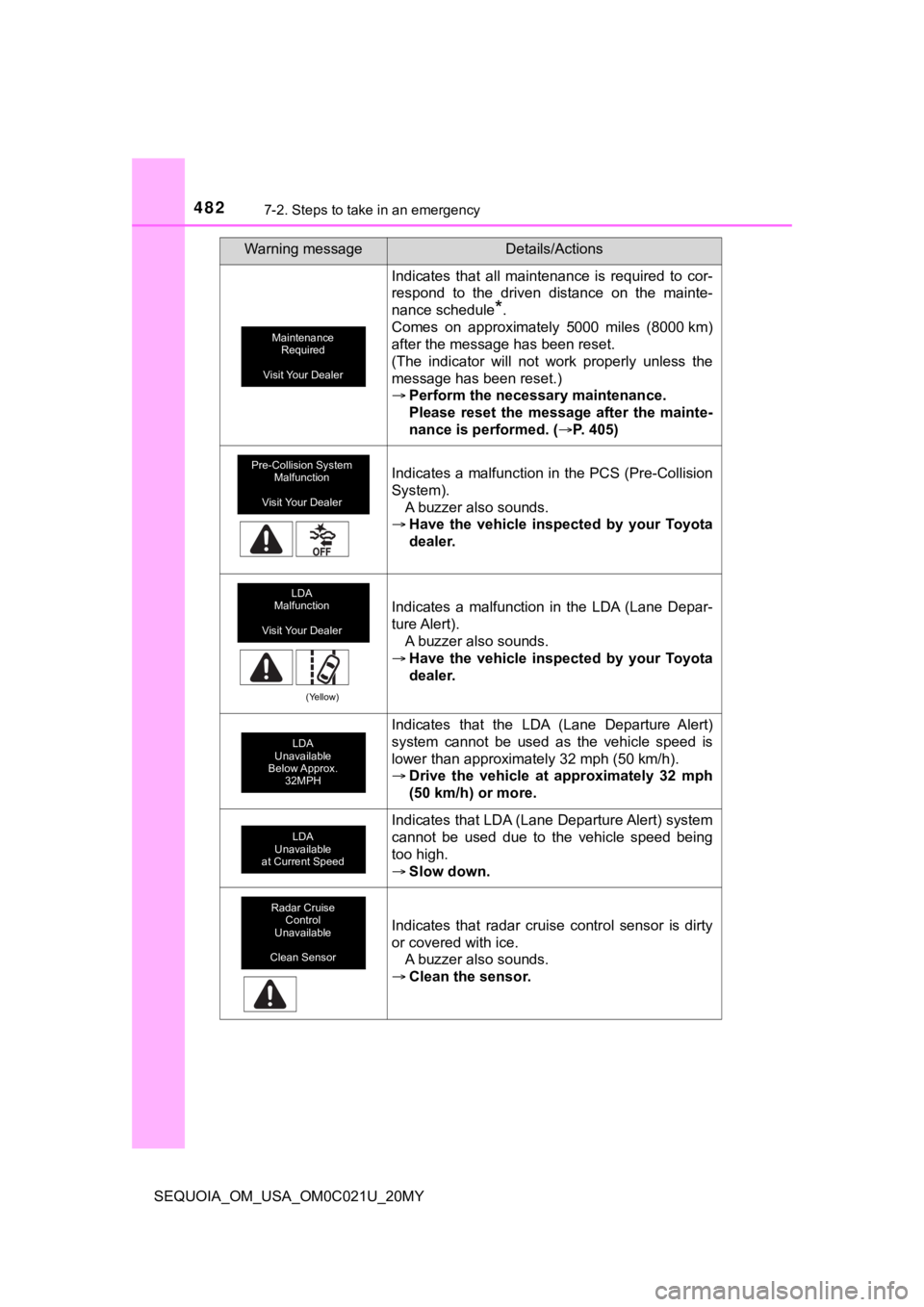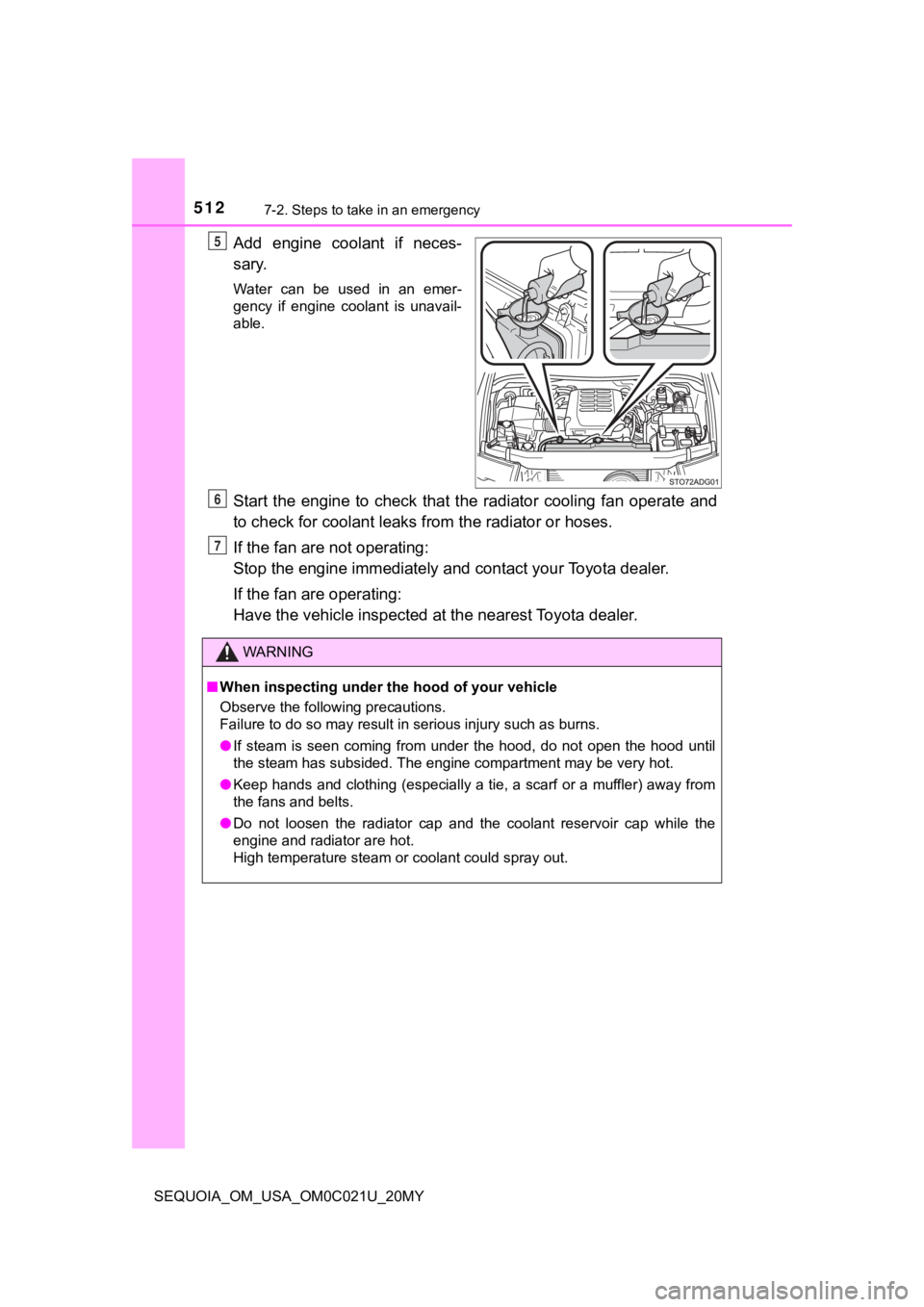ESP TOYOTA SEQUOIA 2020 (in English) Workshop Manual
[x] Cancel search | Manufacturer: TOYOTA, Model Year: 2020, Model line: SEQUOIA, Model: TOYOTA SEQUOIA 2020Pages: 588, PDF Size: 12.33 MB
Page 475 of 588

4757-2. Steps to take in an emergency
7
When trouble arises
SEQUOIA_OM_USA_OM0C021U_20MY
WARNING
■Maintenance of the tires
Each tire, including the spare (if provided), should be checked monthly
when cold and inflated to the inflation pressure recommended by the
vehicle manufacturer on the vehicle placard or tire inflation p ressure
label (tire and load information label). (If your vehicle has t ires of a dif-
ferent size than the size indica ted on the vehicle placard or tire inflation
pressure label [tire and load information label], you should de termine
the proper tire inflation p ressure for those tires.)
As an added safety feature, your vehicle has been equipped with a tire
pressure monitoring system (TPMS -tire pressure warning system) that
illuminates a low tire pressure telltale (tire pressure warning light) when
one or more of your tires is significantly under-inflated. Acco rdingly,
when the low tire pressure telltale (tire pressure warning ligh t) illumi-
nates, you should stop and check your tires as soon as possible , and
inflate them to the proper pressure. Driving on a significantly under-
inflated tire causes the tire to overheat and can lead to tire failure.
Under-inflation also reduces fuel efficiency and tire tread lif e, and may
affect the vehicle’s handl ing and stopping ability.
Please note that the TPMS (tire pressure warning system) is not a sub-
stitute for proper tire maintena nce, and it is the driver’s responsibility to
maintain correct tire pressure, even if under-inflation has not reached
the level to trigger illumination of the TPMS low tire pressure telltale (tire
pressure warning light).
Your vehicle has also been equipped with a TPMS (tire pressure warn-
ing system) malfunction indicato r to indicate when the system is not
operating properly. The TPMS (tire pressure warning system) mal func-
tion indicator is combined with the low tire pressure telltale (tire pressure
warning light). When the system detects a malfunction, the tell tale will
flash for approximately one mi nute and then remain continuously illumi-
nated. This sequence will continue upon subsequent vehicle star t-ups
as long as the malfunction exists . When the malfunction indicator is illu-
minated, the system may not be able to detect or signal low tir e pres-
sure as intended.
TPMS (tire pressure warning system) malfunctions may occur for a vari-
ety of reasons, including the installation of replacement or al ternate tires
or wheels on the vehicle that prevent the TPMS (tire pressure w arning
system) from functioning properly. Always check the TPMS (tire pres-
sure warning system) malfunction telltale after replacing one or more
tires or wheels on your vehicle to ensure that the replacement or alter-
nate tires and wheels allow the TPMS (tire pressure warning sys tem) to
continue to function properly.
Page 482 of 588

4827-2. Steps to take in an emergency
SEQUOIA_OM_USA_OM0C021U_20MY
Indicates that all maintenance is required to cor-
respond to the driven distance on the mainte-
nance schedule
*.
Comes on approximately 5000 miles (8000 km)
after the message has been reset.
(The indicator will not work properly unless the
message has been reset.)
Perform the necessary maintenance.
Please reset the message after the mainte-
nance is performed. ( P. 405)
Indicates a malfunction in the PCS (Pre-Collision
System).
A buzzer also sounds.
Have the vehicle inspected by your Toyota
dealer.
Indicates a malfunction in the LDA (Lane Depar-
ture Alert).
A buzzer also sounds.
Have the vehicle inspected by your Toyota
dealer.
Indicates that the LDA (Lane Departure Alert)
system cannot be used as the vehicle speed is
lower than approximately 32 mph (50 km/h).
Drive the vehicle at approximately 32 mph
(50 km/h) or more.
Indicates that LDA (Lane Departure Alert) system
cannot be used due to the vehicle speed being
too high.
Slow down.
Indicates that radar cruise control sensor is dirty
or covered with ice.
A buzzer also sounds.
Clean the sensor.
Warning messageDetails/Actions
Maintenance
Required
Visit Your Dealer
Pre-Collision System Malfunction
Visit Your Dealer
LDA
Malfunction
Visit Your Dealer
(Yellow)
LDA
Unavailable
Below Approx. 32MPH
LDA
Unavailable
at Current Speed
Radar Cruise Control
Unavailable
Clean Sensor
Page 509 of 588

5097-2. Steps to take in an emergency
7
When trouble arises
SEQUOIA_OM_USA_OM0C021U_20MY
■Starting the engine when t he battery is discharged
The engine cannot be started by push-starting.
■ To prevent battery discharge
●Turn off the headlights and the audio system while the engine is off.
● Turn off any unnecessary electrical components when the vehicle is running
at a low speed for an extended period, such as in heavy traffic .
■ Charging the battery
The electricity stored in the battery will discharge gradually even when the
vehicle is not in use, due to natural discharge and the draining effects of cer-
tain electrical appliances. If the vehicle is left for a long t ime, the battery may
discharge, and the engine may be unable to start. (The battery recharges
automatically during driving.)
■ When recharging or replacing the battery
●In some cases, it may not be possible to unlock the doors using the smart
key system when the battery is discharged. Use the wireless rem ote control
or the mechanical key to lock or unlock the doors.
● The engine may not start on the first attempt after the battery has recharged
but will start normally after the second attempt. This is not a malfunction.
● The engine switch mode is memorized by the vehicle. When the ba ttery is
reconnected, the system will return to the mode it was in befor e the battery
was discharged. Before disconnecting the battery, turn the engine switch off.
If you are unsure what mode the engine switch was in before the battery dis-
charged, be especially careful when reconnecting the battery.
Page 512 of 588

5127-2. Steps to take in an emergency
SEQUOIA_OM_USA_OM0C021U_20MY
Add engine coolant if neces-
sary.
Water can be used in an emer-
gency if engine coolant is unavail-
able.
Start the engine to check that the radiator cooling fan operate and
to check for coolant leaks from the radiator or hoses.
If the fan are not operating:
Stop the engine immediately and contact your Toyota dealer.
If the fan are operating:
Have the vehicle ins pected at the nearest Toyota dealer.
5
WARNING
■When inspecting under th e hood of your vehicle
Observe the following precautions.
Failure to do so may result in serious injury such as burns.
● If steam is seen coming from under the hood, do not open the ho od until
the steam has subsided. The engine compartment may be very hot.
● Keep hands and clothing (especially a tie, a scarf or a muffler ) away from
the fans and belts.
● Do not loosen the radiator cap and the coolant reservoir cap wh ile the
engine and radiator are hot.
High temperature steam or coolant could spray out.
6
7
Page 537 of 588

5378-1. Specifications
8
Vehicle specifications
SEQUOIA_OM_USA_OM0C021U_20MY■
Temperature A, B, C
The temperature grades are A (
the highest), B, and C, representing
the tire’s resistance to the ge neration of heat and its ability to dissi-
pate heat when tested under contr olled conditions on a specified
indoor laboratory test wheel.
Sustained high temperature can c ause the material of the tire to
degenerate and reduce tire life, and excessive temperature can lead
to sudden tire failure.
Grade C corresponds to a level of performance which all passeng er
car tires must meet under the Fe deral Motor Vehicle Safety Stan-
dard No. 109.
Grades B and A represent higher levels of performance on the labo-
ratory test wheel than the minimum required by law.
Warning: The temperature grades of a tire assume that it is pro perly
inflated and not overloaded.
Excessive speed, underinflation, or excessive loading, either sepa-
rately or in combination, can c ause heat buildup and possible t ire
failure.
Page 563 of 588

563
9
For owners
SEQUOIA_OM_USA_OM0C021U_20MY
Votre véhicule est équipé de COUSSINS GONFLABLES
INTELLIGENTS (ADVANCED AIRBAGS) conçus selon les normes de
sécurité américaines applicables aux véhicules à moteur
(FMVSS208). Le boîtier électronique de coussins gonflables (ECU )
utilise les informations reçues des capteurs, etc. détaillés dans le
schéma ci-dessus de composition du système pour commander le
déploiement des coussi ns gonflables. Ces informations comprenne nt
des informations sur la gravité de la collision et les occupants. Le
déploiement rapide des coussins gonflables est obtenu au moyen
d’une réaction chimique dans les dispositifs pyrotechniques, qui
produit un gaz inoffensif permett ant d’amortir le mouvement des
occupants.
AVERTISSEMENT
■ Précautions avec les coussins gonflables SRS
Respectez les précautions suivantes concernant les coussins gon flables
SRS.
À défaut, des blessures graves, voire mortelles, pourraient s’ensuivre.
● Le conducteur et tous les passagers à bord du véhicule doivent porter leur
ceinture de sécurité correctement.
Les coussins gonflables SRS sont des dispositifs de protection
complémentaires aux ceintures de sécurité.
● Le coussin gonflable SRS conducteur se déploie avec une puissan ce
considérable et peut occasionner des blessures graves, voire mo rtelles,
notamment lorsque le conducteur se trouve très près du coussin
gonflable. L’autorité fédérale chargée de la sécurité routière aux États-
Unis, la NHTSA (National Highway Traffic Safety Administration) conseille:
Sachant que la zone de danger pour le coussin gonflable conduct eur se
trouve dans les premiers 2 à 3 in. (50 à 75 mm) du déploiement, placez-
vous à 10 in. (250 mm) du coussin gonflable conducteur pour gara ntir
une marge de sécurité suffisante. Cette distance est à mesurer entre le
moyeu du volant de direction et le sternum. Si vous êtes assis à moins de
10 in. (250 mm), vous pouvez changer votre position de conduite de
plusieurs façons:
• Reculez votre siège le plus possible, tout en continuant à pou voir
atteindre confortablement les pédales.
• Inclinez légèrement le dossier du siège. Bien que les véhicules soient différents les uns des autres, la plupart
des conducteurs peuvent s’asseoir à une distance de 10 in. (250 mm),
même avec le siège conducteur complètement avancé, simplement e n
inclinant un peu le dossier de siège. Si vous avez des difficultés à voir
la route après avoir incliné votre siège, utilisez un coussin f erme et
antidérapant pour vous rehausser ou, si votre véhicule est équi pé du
réglage en hauteur du siège, remontez-le.
• Si votre volant de direction est réglable, inclinez-le vers le bas. Cela
vous permet d’orienter le coussin gonflable vers votre buste plutôt que
vers la tête et le cou.
Le siège doit être réglé selon les recommandations de la NHTSA ci-
dessus, tout en conservant le contrôle des pédales et du volant, et la vue
des commandes au tableau de bord.
Page 566 of 588

566
SEQUOIA_OM_USA_OM0C021U_20MY
AVERTISSEMENT
■Précautions avec les coussins gonflables SRS
● Ne pas suspendre aux crochets à vêtements un cintre nu ni aucun objet
dur ou tranchant. En cas de déploiement des coussins gonflables SRS
rideau, tous ces objets pourraient se transformer en projectile s et causer
des blessures graves, voire mortelles.
● Si une housse en vinyle recouvre la partie où le coussins gonfl able SRS
de genoux se déploie, veillez à l’enlever.
● N’utilisez pour les sièges auc un accessoire venant recouvrir le s parties où
se déploient les coussins gonflables SRS latéraux, car il risqu erait d’en
gêner le déploiement. De tels accessoires peuvent empêcher les coussins
gonflables latéraux de fonctionner correctement, neutraliser le système ou
provoquer le déploiement accidentel des coussins gonflables lat éraux,
provoquant ainsi des blessures graves, voire mortelles.
● Évitez de faire subir des chocs ou des pressions excessives aux zones
renfermant les composants des coussins gonflables SRS.
En effet, cela pourrait entraîner un mauvais fonctionnement des coussins
gonflables SRS.
● Ne touchez aucun composant du système immédiatement après le
déclenchement (déploiement) des coussins gonflables SRS, car ils sont
alors encore très chauds.
● Si vous avez des difficultés à respirer après le déploiement des coussins
gonflables SRS, ouvrez une porte ou une vitre pour faire entrer de l’air
frais, ou bien descendez du véhicule si cela ne présente pas de danger.
Retirez tout résidu dès que possible afin d’éviter d’éventuelles irritations
de la peau.
● Si les parties renfermant les coussins gonflables SRS, telles q ue la
garniture centrale du volant de direction et les garnitures de montants
avant et arrière, apparaissent abîmées ou craquelées, faites-le s remplacer
par votre concessionnaire Toyota.
● Ne rien poser sur le siège du passager avant, comme un coussin par
exemple. Cela a pour conséquence de répartir le poids du passag er sur
toute la surface du siège, ce qui empêche le capteur de détecte r
normalement le poids du passager. En conséquence, les coussins
gonflables SRS frontaux du passager avant peuvent ne pas se dép loyer
en cas de collision.